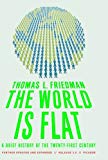
The World Is Flat is a book by Thomas Friedman discussing the trends of globalization in the 21st century. Friedman describes himself as a "free-trader," arguing in favor of the rapid shifts towards a more interconnected economic world after the fall of the USSR as a result of the Internet, computers, outsourcing and workflow software. Friedman also presents his controversial Dell Theory of Conflict Prevention: that corporations' increased dependency on foreign labor and resources will prevent armed conflict.
In a call to action, Friedman stresses that we simply cannot do things the same old way anymore and people must be willing to change and adapt. He compares our current crisis to that we faced in competing with the Soviet Union and the launch of Sputnik; the main challenge then came from those who wanted to put up walls while we now have to face those who want to tear them down. Now, as then, we must change our strategy to overcome these issues. He discusses the difficulty in getting America to stand up and take notice of the importance of this issue in a supercharged society where hype and terror are needed to get the public’s attention and support.
Friedman stresses the importance of shoving political barriers aside in what he calls“compassionate flatism” to prepare our country for what lies ahead. He questions leadership and education; who will lead us into the forefront of this new globalized economy? The necessity for lifelong learning and benefits to allow workers to remain mobile and adaptable is very real, though itseems to be at the bottom of our to-do list.
Finally, Friedman examines how companies such as Capital One are working on the lifelong learning objective by providing training and upgrading to employees, increasing their own productivity and bottom line in the process, as he calls for social programs that encourage workers to be creative and hardworking.
Already have an account? Log In Now